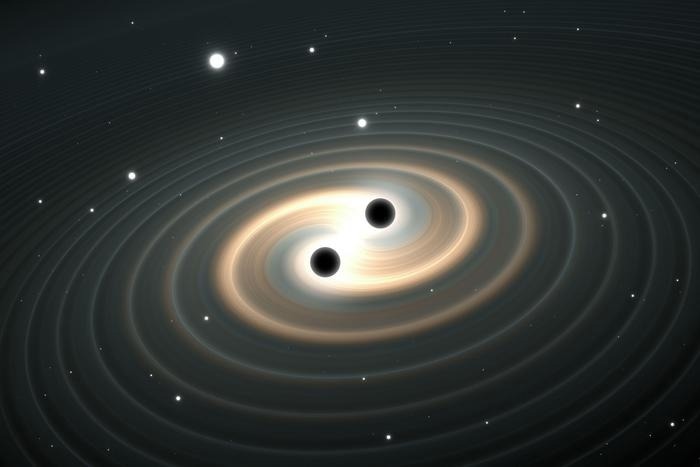Researchers at the Universities of Birmingham and Sussex have introduced a novel method for identifying gravitational waves within the milli-Hertz frequency spectrum, enabling the observation of astrophysical and cosmological events that remain undetectable by existing instruments. The study was published in the journal Classical and Quantum Gravity.
 Gravitational waves from merging black holes. 3D illustration. Image Credit: Peter Jurik/Alamy
Gravitational waves from merging black holes. 3D illustration. Image Credit: Peter Jurik/Alamy
Gravitational waves (ripples in spacetime first predicted by Einstein) have been detected at high frequencies by ground-based interferometers like LIGO and Virgo, and at ultra-low frequencies using pulsar timing arrays. However, the mid-frequency band remains a significant gap in observational coverage.
The proposed detector concept uses cutting-edge optical cavity systems and atomic clock technologies to detect gravitational waves in the elusive milli-Hertz frequency range (10?5–1 Hz) .
The study introduced a detector that leverages advancements in optical resonator technology, which was initially created for optical atomic clocks, to detect minute phase shifts in laser light induced by the passage of gravitational waves. In contrast to large-scale interferometers, these detectors are compact and exhibit a greater resilience to seismic and Newtonian noise.
By using technology matured in the context of optical atomic clocks, we can extend the reach of gravitational wave detection into a completely new frequency range with instruments that fit on a laboratory table. This opens the exciting possibility of building a global network of such detectors and searching for signals that would otherwise remain hidden for at least another decade.
Dr. Vera Guarrera, Study Co-Author, University of Birmingham
The milli-Hertz frequency range, often referred to as the 'mid-band', is anticipated to receive signals from numerous astrophysical and cosmological origins, including compact binaries of white dwarfs and mergers of black holes.
Aspirational space missions like LISA are also aimed at this frequency range, although their launch is planned for the 2030s. Meanwhile, the suggested optical resonator detectors could start investigating this domain at present.
This detector allows us to test astrophysical models of binary systems in our galaxy, explore the mergers of massive black holes, and even search for stochastic backgrounds from the early universe. With this method, we have the tools to start probing these signals from the ground, opening the path for future space missions.
Xavier Calmet, Study Co-Author and Professor, University of Sussex
Although upcoming space missions such as LISA will deliver enhanced sensitivity, their implementation is still more than ten years away. The suggested optical cavity detectors present an immediate and cost-efficient approach to investigating the milli-Hz frequency range.
Furthermore, the research indicates that the integration of these detectors with current clock networks could facilitate the detection of gravitational waves at even lower frequencies, thereby complementing high-frequency observatories such as LIGO.
Each unit is composed of two orthogonal ultrastable optical cavities along with an atomic frequency reference, which enables the multi-channel detection of gravitational wave signals. This setup not only improves sensitivity but also permits the identification of wave polarization and the direction of the source.
Journal Reference:
Barontini, G., et al. (2025) Detecting milli-Hz gravitational waves with optical resonators. Classical and Quantum Gravity. doi.org/10.1088/1361-6382/ae09ec